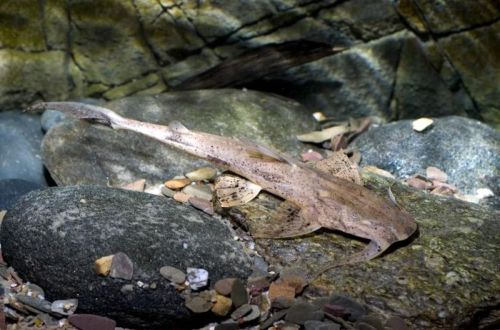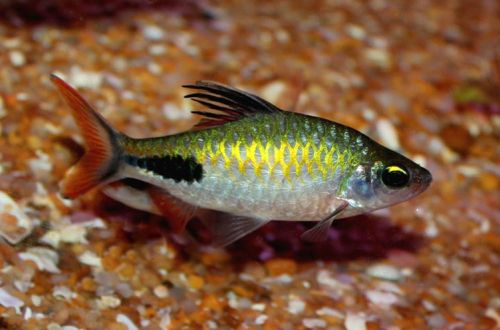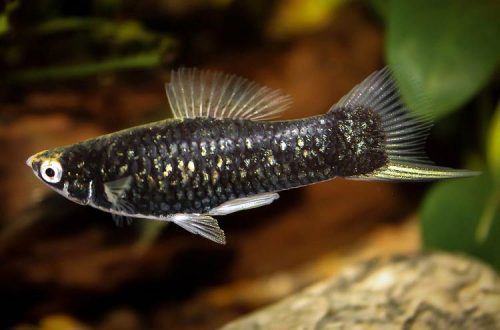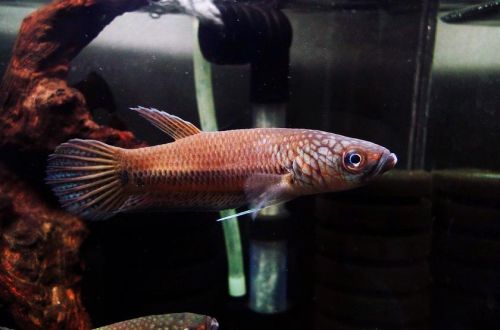
Crocodile catfish
The crocodile catfish, scientific name Bagarius suchus, belongs to the family Sisoridae (Bagar or mountain catfish). Large predatory fish, characterized by a difficult disposition. Its maintenance is costly and time consuming if you do it yourself. Rarely seen in the hobby aquarium hobby and not recommended for beginners.

Contents
Habitat
It comes from Southeast Asia from the basin of the largest river in the Mekong region, flowing through the territory of Thailand, Laos and Cambodia, as well as the Chao Phraya River and its tributaries in the same Thailand. In nature, it occurs in the main channels of rivers in areas with a fast, sometimes violent current, where it hides among boulders and large stones.
Brief information:
- The volume of the aquarium – from 1000 liters.
- Temperature – 18-23°C
- Value pH — 6.0–7.5
- Water hardness – 2–12 dGH
- Substrate type – sandy
- Lighting – subdued
- Brackish water – no
- Water movement – moderate or strong
- Fish size – 65-70 cm
- Nutrition – live, fresh or frozen food
- Temperament – inhospitable
- Content single
Description
Adult individuals reach a length of 65–70 cm. Catfish has a straight, somewhat flattened body and a very narrow head. Near the mouth is a pair of massive whiskers. Such a structure helps him squeeze into the crevices between boulders in search of food, as well as effectively resist the current. The color is light brown with black dots. Thanks to this camouflage, it is difficult to see the fish against the background of a sandy substrate.
Food
A predator that feeds on small fish, amphibians, crustaceans and other invertebrates. In a home aquarium, the diet may be appropriate or consist of fresh or frozen alternative foods such as bloodworms, earthworms, chopped shrimp, shellless mussels, and the like. Specialized commercial foods for carnivorous species are a good choice.
Maintenance and care, arrangement of the aquarium
Such a large size of the fish implies the presence of a large aquarium from 1000 liters. With its content, it is necessary to ensure internal flow and a high content of dissolved oxygen, maintain the hydrochemical composition of water and temperature within acceptable ranges, and also prevent the accumulation of organic waste. The decoration is chosen to resemble the natural environment, in particular, subdued lights and several shelters on sandy ground. These are just the main tasks that an aquarist will have to solve if he acquires a Crocodile catfish.
The installation and maintenance of such an aquarium (the total weight with water can reach more than a ton) is associated with significant costs and expenses. This is not only the purchase of expensive equipment and a reservoir, but also construction work and the laying of utilities to automate a number of procedures. For example, water treatment and regular renewal of water in the amount of 50–70% for fresh water.
Behavior and Compatibility
Given the diet, choosing compatible species is not an easy task, and besides, the catfish is not very friendly towards relatives and other bottom fish encroaching on its territory.
Fish diseases
The cause of most diseases is unsuitable conditions of detention. A stable habitat will be the key to successful keeping. In the event of symptoms of the disease, first of all, the quality of the water should be checked and, if deviations are found, measures should be taken to correct the situation. If symptoms persist or even worsen, medical treatment will be required. Read more about symptoms and treatments in the Aquarium Fish Diseases section.





